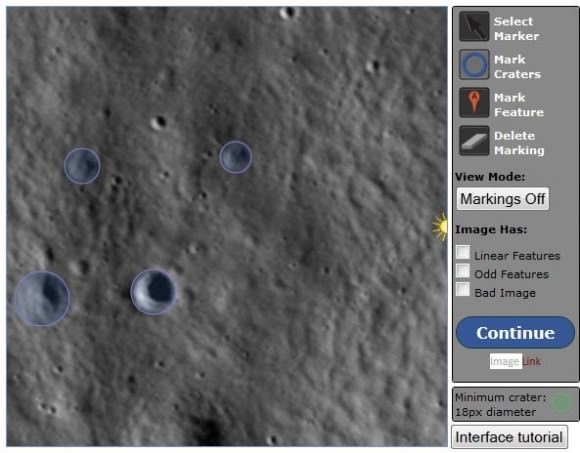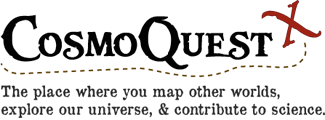“X” marks the spot for a new place for Citizen Science on the web. It’s called CosmoQuest and the collaborators of this new website invite you to come visit and do more than just click your mouse. Besides contributing to real science for NASA space missions, there are also places to learn, converse, hang out and socialize.
“We’re building a community that recreates an academic and research facility,” said Pamela Gay, from Southern Illinois University, Edwardsville, who is familiar to listeners of Astronomy Cast and 365 Days of Astronomy, and readers of her blog StarStryder. “We’ll be doing open science in an open-source way.”
Universe Today is one of the partners for CosmoQuest, along with Phil Plait from Bad Astronomy and the BAUT Forum (Bad Astronomy Universe Today forum) that Fraser Cain and Phil created for online discussion.
“Fraser and Phil successfully built a community within the BAUT Forum, and we see many of the same people there that are subscribers to our podcasts,” said Pamela. “One of the ideas behind CosmoQuest was to see if we could take this community of people that are interested in content and transform them into a community of people who are not just reading about or listening to astronomy and commenting on our feeds, but are also actively engaged in doing astronomy and science and want to learn more.”
Our readers have probably noticed –and hopefully participated in or watched — the new Weekly Space Hangouts that cover the news of the week, and the live telescope feeds that Fraser has been doing with amateur astronomers from around the world. This is all stems from CosmoQuest, and the CosmoQuest website will be the place where you can find all the feeds for the Hangouts and livestream star parties, and soon you’ll be able to sign up to get email notifications of these upcoming events. There will also be podcast feeds, a blog, an events calendar, and a forum. Later, there will be free (and premium) online classes, lectures, and other ways to participate and learn more about astronomy.
“We’ve got amateur astronomers out there who are doing amazing observations with their telescopes,” Fraser said. “We’ll be able to share tips and observing techniques, as well as exposing more people to the night sky. There will also be talks by scientists and experts in the field. In a way, this will be a way for those interested in astronomy to participate and learn without having to pay $1,000 a credit to get an advanced degree.”
But Citizen Science is the major part of CosmoQuest. “We know that the general public who are interested in science can contribute to science in meaningful ways,” said Pamela. “We’re building tools to bring researchers together with the public.”
CosmoQuest’s first project, which is currently in beta, is called Moon Mappers, which uses data from the Lunar Reconnaissance Orbiter.

“Right now in beta, we have full functionality of two interface tasks,” said Stuart Robbins from the University of Colorado Boulder, a co-lead for the Moon Mappers science team. “There are ‘Simply Craters’ and ‘Man vs. Machine.’ In the former, users are asked to draw a circle to trace out a crater. They click in the center of the crater, drag outwards, and release. They can also flag features that they think are interesting to point out to the science team. Man vs. Machine is the same thing, except I’ve run an automated crater detection algorithm to find craters in the image already. We ask users to correct ones it got wrong, remove ones it marked as craters that aren’t, and add craters it missed. We’re trying to study a few things with that interface, including whether it saves time and how we can improve our algorithms.”
The goal of Moon Mappers is to find the most effective and accurate way to map the Moon.
“Do we have people do it all by themselves? Do we have people modify the outputs of crater-finding algorithms (which we know are only accurate to 80% or better)? Under what lighting conditions are both humans and software most accurate in what they do?” Pamela said. “We’re looking at how we can most effectively map the Moon as quickly as possible through a combination of humans and computers using NASA imagery from LRO.”
In beta, they want to find any problems with the interface.
“What we really need are people who don’t know the project to come in and actually use it and point out what we may have missed in terms of functionality, bugs, or other things,” said Stuart. “For example, when we first went live on January 9, there was a user in the Forum discussion, Justin (“Briliu”) who made several interface change suggestions. We’ve made them all.”
They also want to make sure that the tutorials to train the Citizen Scientists works well, which will help in creating future programs, which will include data from the Dawn mission, MESSENGER, and the Hubble Space Telescope.
Pamela and Stuart both have ample experience in leading Citizen Science projects, as Pamela has been with the Zooniverse project for several years, specifically Moon Zoo, as has Stuart.
“One of the advantages of Moon Mappers is that because we are a much smaller and more open community we are willing to say yes to almost anything that we have the ability to construct,” said Pamela. “One of our biggest differences from Zooniverse is our intent to go open source with all of our code. This means that in those instances when we can’t help someone, we can say. ‘here is our code, we’ll help you get started.'”
CosmoQuest has already posted the code for their Google Hangout On Air + Twitter social media mashup.
Pamela added that CosmoQuest will differentiate itself by stressing community-building and learning.
Community partners for CosmoQuest include The Planetary Society, Astronomers Without Borders, the Meta Institute for Computational Astrophysics and educational partners are the Ward Bleecher Planetarium, Swinburne Astronomy Online and the Galileo Teacher Training Program.
Check out CosmoQuest and Moon Mappers.


Great initiative. The human eye is still beter than any computer.
I wonder if it is possible to set up a similar projects that allows the general public to search for red and brown stars in the WISE infrared all sky survey database.